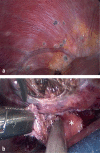Extragenital Endometriosis in the Differential Diagnosis of Non- Gynecological Diseases
- PMID: 35477509
- PMCID: PMC9472266
- DOI: 10.3238/arztebl.m2022.0176
Extragenital Endometriosis in the Differential Diagnosis of Non- Gynecological Diseases
Abstract
Background: Endometriosis is a chronic, benign disease that affects approximately 10% of women of childbearing age. Its characteristic clinical features are dysmenorrhea, dyschezia, dysuria, dyspareunia, and infertility. The manifestations of extragenital endometriosis (EE) are a diagnostic challenge, as this disease can mimic other diseases due to its unusual location with infiltration of various organs and corresponding symptoms.
Methods: This review is based on publications retrieved by a selective search of the literature on the commonest extragenital sites of endometriosis, including the relevant current guideline.
Results: Current evidence on the treatment of extragenital endometriosis consists largely of cohort studies and cross-sectional studies. The treatment is either surgical and/or conservative (e.g., hormonal therapy). Gastrointestinal endometriosis is the most common form of EE, affecting the rectum and sigmoid colon in nearly 90% of cases and typically presenting with dyschezia. Urogenital endometriosis is the second most common form of EE. It affects the bladder in more than 85% of cases and may present with dysuria, hematuria, or irritable bladder syndrome. The diaphragm is the most common site of thoracic endometri - osis, potentially presenting with period-associated shoulder pain or catamenial pneumothorax. Endometriosis affecting a nerve often presents with sciatica. In abdominal wall endometriosis, painful nodules arise in scars from prior abdominal surgery.
Conclusion: There is, as yet, no causally directed treatment for chronic endometriosis. The treatment is decided upon individually in discussion with the patient, in consideration of risk factors and after assessment of the benefits and risks. Timely diagnosis is essential.
Figures
Similar articles
-
Rectosigmoid endometriosis: diagnosis and surgical management.Clin Exp Obstet Gynecol. 1998;25(3):94-6. Clin Exp Obstet Gynecol. 1998. PMID: 9856308
-
Hormone treatment as first line therapy is safe and relieves pelvic pain in women with bowel endometriosis.Einstein (Sao Paulo). 2019 May 2;17(2):eAO4583. doi: 10.31744/einstein_journal/2019AO4583. Einstein (Sao Paulo). 2019. PMID: 31066795 Free PMC article.
-
The diagnosis and treatment of deep infiltrating endometriosis.Dtsch Arztebl Int. 2010 Jun;107(25):446-55; quiz 456. doi: 10.3238/arztebl.2010.0446. Epub 2010 Jun 25. Dtsch Arztebl Int. 2010. PMID: 20644707 Free PMC article.
-
[Endometriosis : An often unrecognized pain disorder].Schmerz. 2016 Oct;30(5):477-490. doi: 10.1007/s00482-016-0154-1. Schmerz. 2016. PMID: 27681777 Review. German.
-
[Extragenital endometriosis: Parietal, thoracic, diaphragmatic and nervous lesions. CNGOF-HAS Endometriosis Guidelines].Gynecol Obstet Fertil Senol. 2018 Mar;46(3):319-325. doi: 10.1016/j.gofs.2018.02.001. Epub 2018 Mar 9. Gynecol Obstet Fertil Senol. 2018. PMID: 29530553 Review. French.
Cited by
-
[When you hear hoofbeat, look for zebras-A rare cause of right-sided lower abdominal pain].Chirurgie (Heidelb). 2023 Mar;94(3):265-267. doi: 10.1007/s00104-022-01765-x. Epub 2022 Nov 28. Chirurgie (Heidelb). 2023. PMID: 36441202 German. No abstract available.
-
Understanding Deep Endometriosis: From Molecular to Neuropsychiatry Dimension.Int J Mol Sci. 2025 Jan 20;26(2):839. doi: 10.3390/ijms26020839. Int J Mol Sci. 2025. PMID: 39859551 Free PMC article. Review.
-
Thoracic Endometriosis Syndrome (TES) in Martinique, a French West Indies Island.J Clin Med. 2023 Aug 26;12(17):5578. doi: 10.3390/jcm12175578. J Clin Med. 2023. PMID: 37685644 Free PMC article.
-
Association between exposure to polycyclic aromatic hydrocarbons and endometriosis: data from the NHANES 2001-2006.Front Public Health. 2024 Jan 8;11:1267124. doi: 10.3389/fpubh.2023.1267124. eCollection 2023. Front Public Health. 2024. PMID: 38259796 Free PMC article.
-
MRGPRX2 Mediates Mast Cell-Induced Endometriosis Pain Through the Sensitization of Sensory Neurons via Histamine/HRH1/TRPV1 Signaling Pathway.FASEB J. 2025 Jul 15;39(13):e70778. doi: 10.1096/fj.202501493R. FASEB J. 2025. PMID: 40600649 Free PMC article.
References
-
- Abbas S, Ihle P, Köster I, Schubert I. Prevalence and incidence of diagnosed endometriosis and risk of endometriosis in patients with endometriosis-related symptoms: findings from a statutory health insurance-based cohort in Germany. Eur J Obstet Gynecol Reprod Biol. 2012;160:79–83. - PubMed
-
- Shafrir AL, Farland L v., Shah DK, et al. Risk for and consequences of endometriosis: a critical epidemiologic review. Best Pract Res Clin Obstet Gynaecol. 2018;51:1–15. - PubMed
-
- Zondervan KT, Becker CM, Missmer SA. Endometriosis. N Engl J Med. 2020;382:1244–1256. - PubMed
-
- Hudelist G, Fritzer N, Thomas A, et al. Diagnostic delay for endometriosis in Austria and Germany: causes and possible consequences. Hum Reprod (Oxford, England) 2012;27:3412–3416. - PubMed
Publication types
MeSH terms
LinkOut - more resources
Full Text Sources
Medical



